People
Robin Standefer and Stephen Alesch Broke the Mold With Their Redesign of the Met’s New British Galleries. Now, They’re Opening Their Own Space
The co-founders of New York design firm Roman and Williams opened Guild Gallery last November.
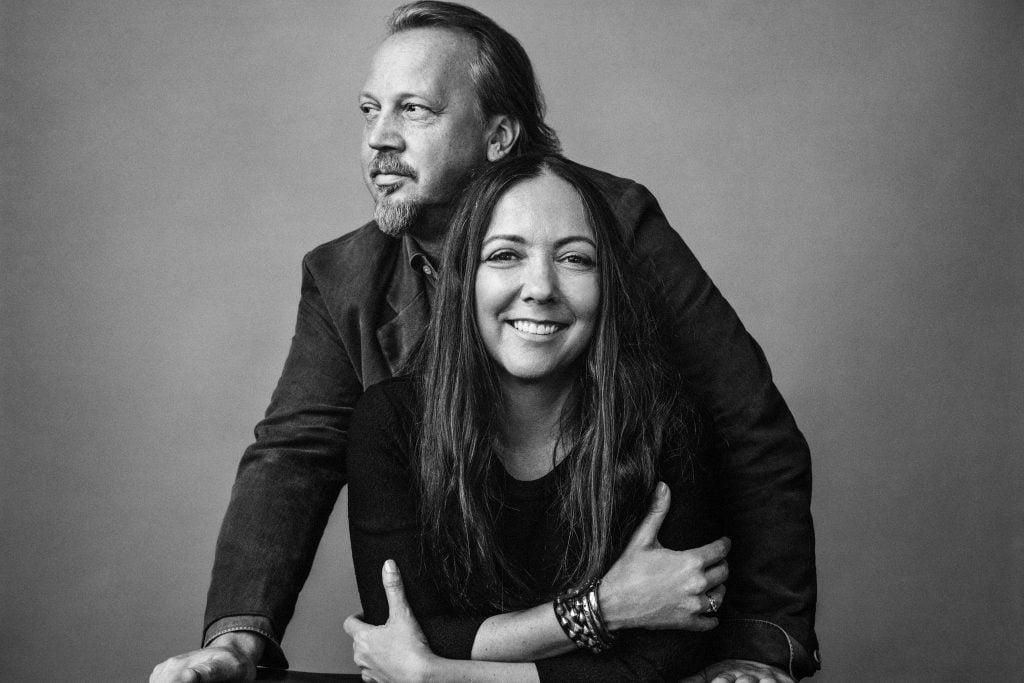
The co-founders of New York design firm Roman and Williams opened Guild Gallery last November.

Noor Brara

Prolific design duo Robin Standefer and Stephen Alesch of the New York-based firm Roman and Williams have long conceived some of the most beautifully designed, immersive spaces in hotels, restaurants, and homes, bringing their art backgrounds to bear on many of the city’s beloved cultural institutions and buildings.
But when, in 2014, the two won their most significant commission to date—a reimagining of the British Galleries at the Metropolitan Museum of Art, a task never before outsourced to an independent design firm—they began to rethink what Roman and Williams could encompass. While falling into a rabbit hole of object research, during which time Standefer admits they became “obsessed” with the history of each treasure in the Met’s collection, the two started to think about what might be next for their own practice.
After the unveiling of the new British Galleries in 2020, Standefer and Alesch began to mull over a new idea: to open Guild Gallery, a natural progression from the RW Guild, their store on Soho’s Canal street that presents small-scale sculptural works and ceramics in a design-meets-restaurant hybrid space where everything is shoppable.
Guild Gallery, which opened in November, is the first “real” gallery from Roman and Williams that seeks to reconsider how the art of the ceramicists and sculptors they’ve worked with could be elevated. Additionally, they sought to reimagine the relationship between artwork and the world in which it lives, which they view as a space that must reflect, in a sense, the materiality and intention of each work.
To discuss their work redesigning the Met’s British Galleries, the opening of Guild Gallery, and why the art world ought to rethink the exhibition experience, we recently spoke to Standefer over Zoom.
To begin, maybe you can tell me a little about how you were selected to re-design the British Galleries at the Met, which as you’ve said is what laid the groundwork for the formation of Guild Gallery.
The Met has never hired a designer that was not in-house to do a suite of permanent galleries. It was an arduous and intensive competition that took two years. We worked with Luke Syson, who is now the director of the Fitzwilliam in Cambridge, but who was then the chairman of decorative arts at the Metropolitan Museum, to finalize our vision. We were certainly an unexpected choice because the other candidates were more like Diller Scofidio or Herzog and de Meuron—the usual suspects for redesigning a permanent wing of a museum. But someone had recommended us and we got the call and competed for it.
In the end I think we received the commission because of how devoted to the objects we were. We had a total obsession with them, and an interest in their history, and that’s something that, sadly—and I want to be careful about how I say this—isn’t usually the case because architects tend to be more focused on the space than the objects. And so that’s something for us, even in our own practice, that’s really important: the idea of what goes into a space being central to how we build it, that a space should have a real relationship to what goes in it. These concepts are quite fundamental to what birthed Guild Gallery, too.
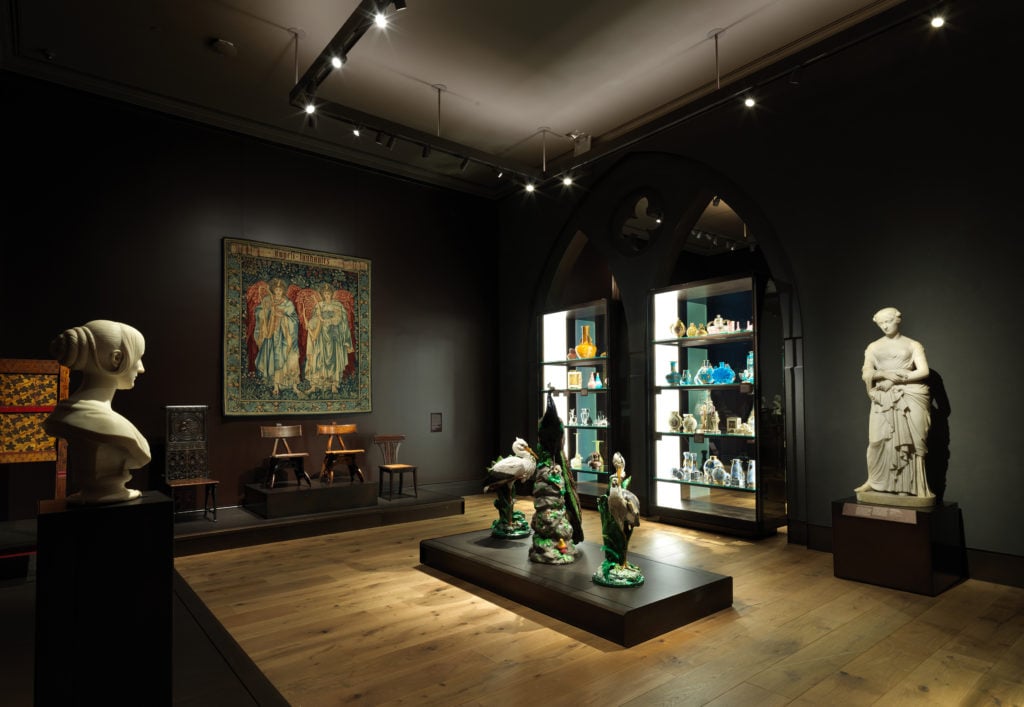
Installation view of the 19th Century Gallery in the Met’s new British Galleries. Photo by Joseph Coscia, February 2020. Courtesy of the Metropolitan Museum of Art.
So how did you realize that mission at the Met, that a space should have a meaningful relationship to what it houses?
We were given the commission after two years of intense presenting to the board and the visitors committee. We had to articulate why we were right and why we thought we could create an experience at the Met that was part of the museum tradition, but also absolutely unique. Finally, we received the commission after that process, and then we embarked for more than five years on actually creating those galleries. Just finding our rhythm required a lot of research and looking—I mean we traveled with the curators to the Rijksmuseum and the Neue Galerie and really got a primer on best-in-class exhibition design. It did strike Stephen and I that many galleries haven’t really embraced this idea of a design language between their objects and installations, whether that was because of cost or the belief many galleries have that it’s about complete austerity to authentically show the work.
The Rijks and the Neue were particularly moving to us and we came back and put our heads down to figure out how to keep the wing’s chronology, its relationship to the rest of the museum, and how its objects were used. At the end of the day, you’re telling a deep, historical story about British history and also world history. The British empire represents the world, and so where does that take us in terms of an object-focused story? Ceramics started to play a huge part in that dialogue.
How did you end up laying all this out? And how did these decisions lead to the formation of RW Guild and then Guild Gallery?
When you think about the history of Britain, you have to think about pottery, pots, containers, and making techniques ancient and modern. We were going from the 15th century to the 19th century. We were so moved by that whole exploration. We were also very interested in sacred geometry and other things that were very core to us and our practice, and in these galleries, we found that there was a tactic of using arches—a Gothic arch, a pointed arch, and so on—to represent the different centuries. We learned a lot about the idea of the threshold and the transition and how that informs your experience. So we worked on the British galleries, and it really propelled us then to open the Guild as well. This is something that we were thinking about, but it was during that journey that we really concretized and made that decision.
So now we’re four years in and the Guild and the Met galleries are opening. For us this relationship of object lust and the power of the utility of the everyday, the sacred in the everyday, the idea of what an object means that gets passed down through centuries and becomes sort of a symbol of family and place and an important cultural relevance to whatever country it’s coming from… it’s all related. We were kind of teasing those ideas out in the RW Guild for a contemporary audience, with the objects that we acquired from the [global roster] of artists [and makers] we were working with. And people started to get very excited about that. But at the same time, we were looking around in the industry and we just weren’t really happy as designers. We were like, “There are so few people who are embracing these techniques, to be able to allow people to actually use things.”
So when I’m thinking about 18th-century Britain and the emergence of the middle class and glassware that was more artisanally made than we have today, I was like, “Whoa, we are going backwards.” We decided to celebrate that and one of the important things was that what we had wasn’t only American-made, or U.K.-made, but it was of global quality. So all of this was percolating for us, and it related to the narrative of the Met’s, which was “creativity in an entrepreneurial society.” That was the brief. So we had to express that in our designs for the galleries, and it was meta, because it was so close to something we were so interested in in our own practice. It felt meant to be.
So then the Met galleries open in 2020 and the museum closes for the first time in 100 years and nobody sees our galleries. Which was sort of… disappointing.
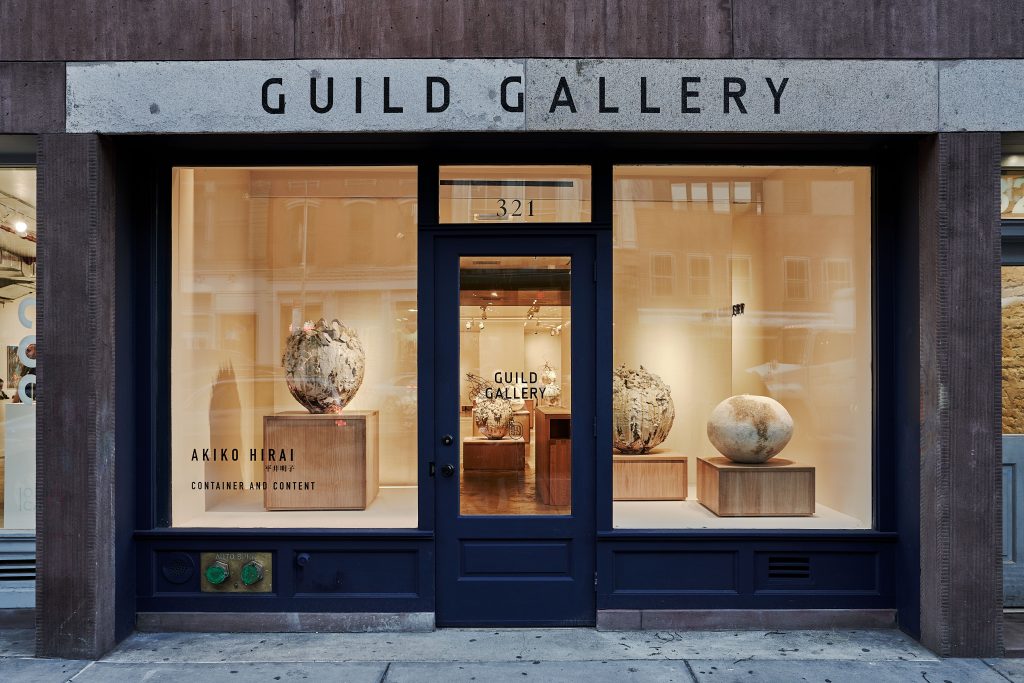
Guild Gallery. Photo courtesy Guild Gallery.
That’s insane.
It was literally open for a week. And then… well, you know.
My god. How did you feel?
It was awfully sad. But now people are going to see the galleries again and, after that, we had an opportunity for us to redefine what art is to us. And so we are really thinking about the power of art, with a capital “A,” as something with intrinsic power, with almost an abstraction but not necessarily—but what defined that to us. In the midst of the pandemic, a lot of the artists at the Guild started to work on a bigger scale and started to really delve into their own practices.
Our restaurant expanded so our store started to become even more about function and a guild of the senses than the mission that it opened with. We always knew it was about flowers, food, utility, and creating a sense of life, and that the accoutrement that goes with that life had to be really thoughtfully made, not disposable and really made by hand—the fundamental core of the RW Guild and Roman and Williams. But then we started to evolve and see some of these artists work at a bigger scale during the pandemic and start to challenge their own materials. And we said, “They’re really starting to outgrow us.” And to be honest, I was actually happy to see some of those artists go to a bigger gallery because I wasn’t really focused on trying to be a big gallery. I was so excited to share their work with the world. But then I was talking to Stephen and we said maybe we have to find a way to actually exhibit—and exhibit is not a word I use at the Guild, where it was all about intersection between things, art, and design. Guild Gallery is about art. So I was like okay, “We have to start to take these objects out of this design context, to give them their own place.”
So then you found a space for this?
We found a space not 50 feet away in a wonderful landmarked building. I grew up in New York City and worked, kind of in a different life, in the art world when I was quite young because I was always interested in art and artists and the dialogue of art and the city. Canal Street is just part of that. In the ’70s, Canal Street had so much artistic power and, as a third-generation New Yorker, it was really exciting to kind of pioneer Canal Street in that way. The gallery is quite refined, and quite precise. It’s not so downtown in that sense. You come off the grit and intensity of that street into this completely contemplated, beautiful space with these remarkable containers made with so much care, so much skill, so much thought. It kind of organically happened to us. We just realized that the evolution of our own practice of the Guild was to say things could be in context but also out of context and focused on celebrating form and also on having solo exhibitions for these sculptor-ceramicists. Not to be immodest, but we’re peerless. There’s nobody who is doing this. And here we are.
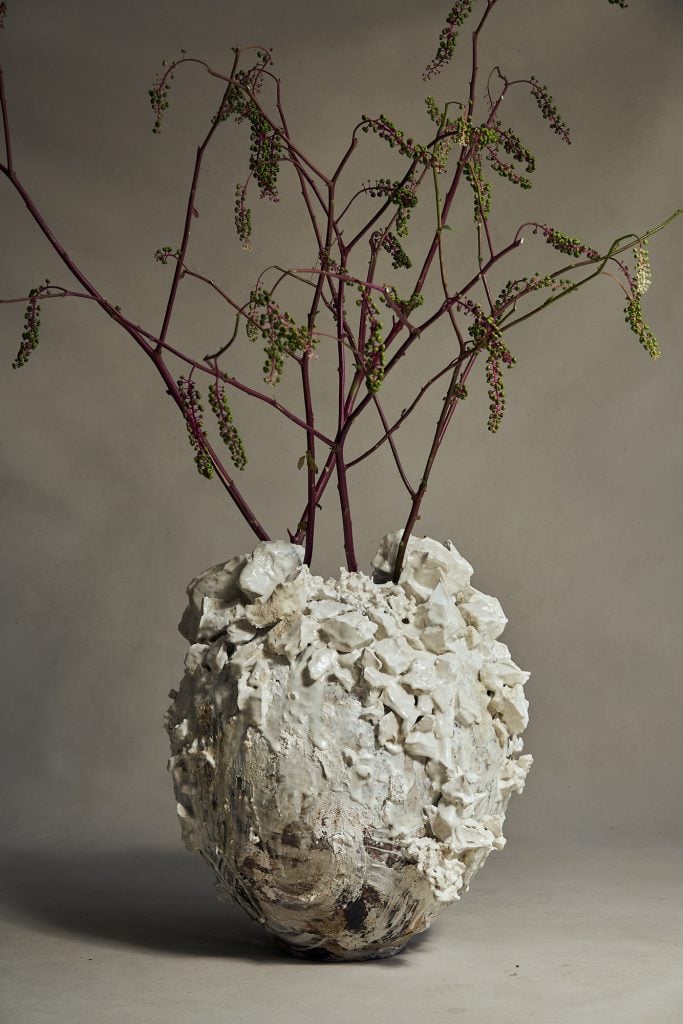
An artwork by Akiko Hirai. Photo courtesy Guild Gallery.
So who is visiting the Guild Gallery? And who are you exhibiting now?
We’ve had major collectors visit. One just bought a piece from an incredible artist, Akiko Hirai, who has been in group shows at Hauser and Wirth and who is going to be having a show there this year. We’re very proud to celebrate her first solo exhibition in the United States and have this collector come and purchase that piece and then say, “Would you mind moving it into the Guild for a moment for me to see it context, in a [more livable] space?” He was already activating the dialogue that Stephen and I were mining. Not that many people have an opportunity to do this. You know, someone sells a Dubuffet to Aby Rosen and then some person like me, as a designer, figures out where to put it… there’s not this kind of dialogue and this is something that we’re interested in exploring more of.
That’s so interesting. You have been ahead of this art and design intersection for quite a while. How do you feel now that more people are beginning to do what you’ve done for so long?
It’s encouraging to hear people say, “Let’s study the space between things.” Let’s appreciate the breathing room between objects. Let’s make sure we’re able to take a breath and look at things. That’s good. And we’re putting a bench in the gallery, which galleries don’t tend to have but museums do.
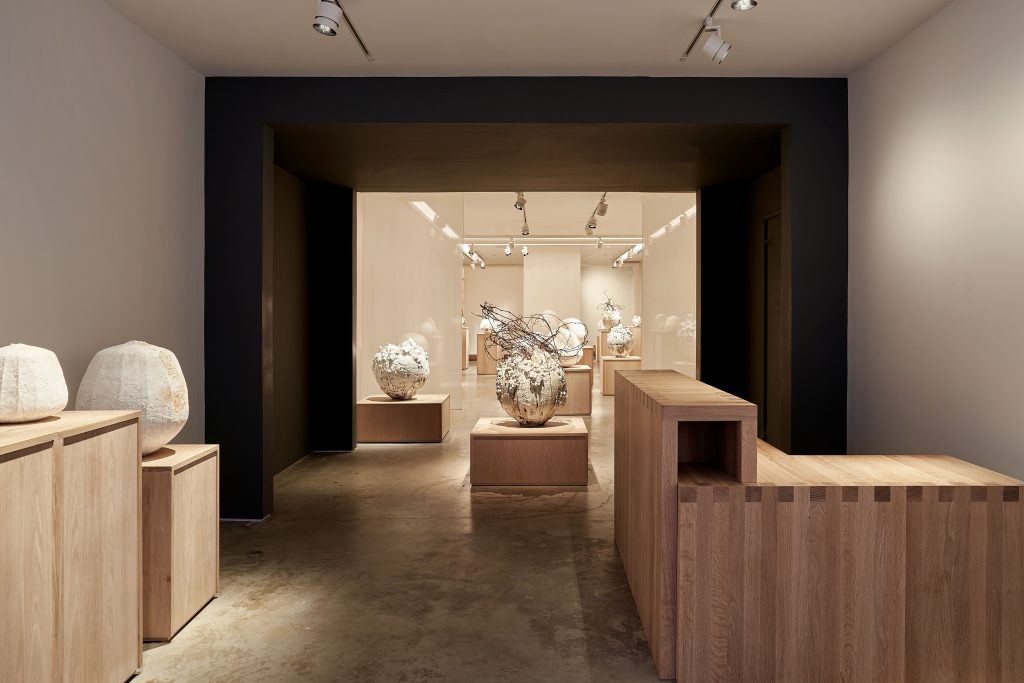
Inside Guild Gallery, featuring work by Akiko Hirai. Photo by Adrian Gaut, courtesy Guild Gallery.
To create a sort of hybridized museum-gallery experience?
We are selling the work. But I do want people to be able to experience it with solitude and precision. The space is about 2,000 square feet and all the pedestals are in oak because they reflect these vessels, these earthly, tactile, clay objects. They’re not the only things we’re going to show and there’s a lot of clay in our roster and program and putting them on these anonymous plaster plinths to us, we wanted more materiality, more of an earthly dialogue.
An important part for us to think about—for Guild Gallery, for the Met—was this idea of how do you reveal the journey? And at the gallery—and at many galleries—you understand the show as you enter a space. It’s all revealed to you kind of immediately and then you go into it more deeply, laser-focused, piece by piece. Even though the gallery is not large, we wanted to create these scrims, fabric panels, to create this journey or reveal. You do also see the pots through the fabric so there is this beautiful, diaphanous moment where you can see the work through something and then come around it to see it again without that translucency. And I think that’s beautiful. It’s about that kind of narrative.